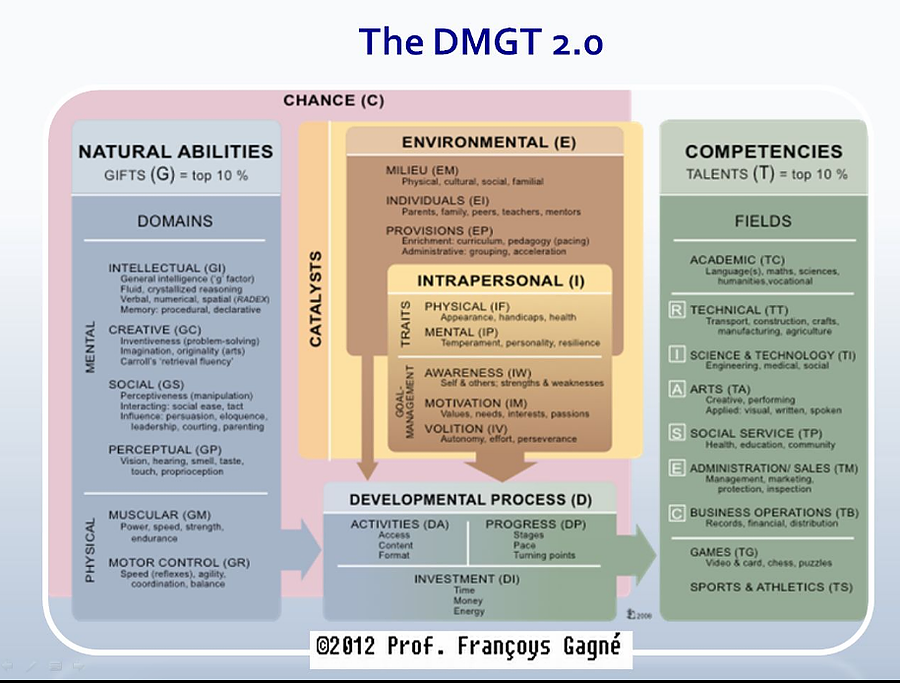The Gagné Model of Giftedness and Talent
Until the mid-1980s, definitions of giftedness and talent used in Australia tended to be performance-based and children or adolescents who were identified as gifted were usually the successful, motivated students who were already achieving. Unfortunately, these rather stereotyped definitions tended to ignore gifted children who, for a range of reasons, had not yet been able to translate their high abilities into achievements.
As early as 1988 a nationwide Senate Enquiry into the education of gifted students in Australia (Senate Select Committee on the Education of Gifted and Talented Children, 1988) identified groups of gifted students who were at particular risk for non-identification.
- gifted children from economically disadvantaged backgrounds
- culturally diverse students learning English as a second language
- children who were gifted but with a learning disability
- gifted students with physical disabilities – for example visually impaired or hearing impaired gifted students
- gifted students in geographically isolated areas
- gifted students whose love of learning had been dimmed by years of repetitive and unchallenging curriculum
- gifted students who deliberately camouflage their abilities for peer acceptance.
In 2001, a second Senate investigation reported that the situation had changed very little in 13 years!
Performance-based definitions disadvantage gifted students who, for whatever reason, are not performing to the level of their ability. A model of giftedness which recognises, and avoids, this problem, has been developed by Françoys Gagné, a French Canadian psychologist. Over the last ten years Gagné’s definition has influenced Australian views of high ability and how it is translated into high achievement. The Gagné model alerts us to ‘hidden gifts’.
Gagné (2003) argues that we should not use the terms ‘giftedness’ and ‘talent’ synonymously. Rather, he suggests that we should use these terms selectively to identify two different stages in a highly able student’s journey from high potential to high performance.

Gifts
Gagné defines giftedness as the possession of natural abilities or aptitudes at levels significantly beyond what might be expected for one’s age, in any domain of human ability. As the diagram below illustrates, a student might be gifted in any one of the cognitive, creative, socio-affective or sensori-motor domains – or in several, or in all.
How many students could be regarded as gifted? Gagné suggests that at least 10%-15% – at least three or four students in a mixed ability class of 30 – could be gifted in the intellectual domain. Another three or four could be physically gifted. And of course there is often overlap between the domains. Of course, in our context it is much higher.
The key to Gagné’s view of giftedness is that it defines outstanding potential rather than outstanding performance. This model recognises the existence, and the dilemma, of the gifted underachiever – the student who may have well above average ability but who has not yet been able to translate this into above average performance.
Talents
While giftedness equates with high ability, talent equates with high achievement. Gagné defines talent as achievement performance at a level significantly beyond what might be expected at a given age. As can be seen from the diagram, giftedness in any specific ability domain could be translated into talent in several different fields of performance. If Don Bradman had been born in the USA, he might have become a talented baseballer!
How does giftedness become talent? At the heart of his model Gagné places something that is also central to us as teachers, the quality of the child’s learning. However, because learning occurs within environmental and personal contexts, he centres the developmental process of learning, training and practising between two clusters of catalysts which can either assist or hinder the child’s learning.
Intrapersonal catalysts
Personality factors within students themselves impact on the learning process.
Motivation and perseverance are critical to success.
Gagné emphasises that many gifted students find school sadly unmotivating: but the motivation to achieve their potential is essential if they are to develop as talented. They must have the motivation to get started, the motivation to apply themselves and the motivation to persevere when the going gets rough!
